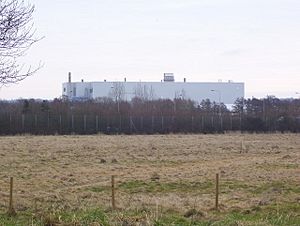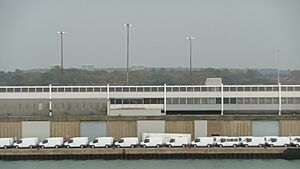Ford Southampton plant facts for kids
 |
|
| Built | 1939 |
|---|---|
| Location | Swaythling, Southampton, England |
| Coordinates | 50°56′37″N 1°22′6″W / 50.94361°N 1.36833°W |
| Industry | Automotive |
| Products | Vans |
| Employees | 500 |
| Area | 44-acre (180,000 m2) |
| Volume | 630,000 square feet (59,000 m2) |
| Defunct | 2013 |

The Ford Southampton plant was a large factory located in Swaythling, a town near Southampton, England. For many years, it was the main place in western Europe where Ford Transit vans were built. The very last vehicle was made there on July 26, 2013. This marked the end of Ford making vehicles in the UK.
Contents
History of the Ford Southampton Plant
Building the Factory
The factory was built on a large piece of land, about 44-acre (180,000 m2) big. It was close to Southampton Airport. It first opened on February 2, 1939. At that time, it was a special kind of factory called a "shadow factory." This meant it was built to make parts for airplanes, specifically for a company called Cunliffe-Owen Aircraft.
World War II and Spitfires
When World War II started, the factory changed its focus. It began making parts for the famous Supermarine Spitfire airplane. This was a very important job for the British war effort. Because it was so important, the German air force, called the Luftwaffe, bombed the factory several times. The first bombing happened in September 1940. Later in the war, the factory even started putting together whole Spitfire planes.
Ford Takes Over
After the war, in 1947, the original company, Cunliffe-Owen, ran into financial trouble. In 1949, another company called Briggs Motor Bodies bought the factory. Briggs made car bodies for Ford of Britain. Then, in 1953, Ford bought Briggs, which meant they also took over the Southampton factory. The factory was now 630,000 square feet (59,000 m2) in size. It started making truck bodies, which were then sent to another Ford plant in Slough to be put onto truck chassis.
Making the Ford Transit Van
In 1965, Ford began making the Ford Transit van in Great Britain. The bodies were made in Swaythling and then driven to the Langley, Berkshire factory to be joined with the chassis.
In 1972, Ford invested a lot of money, about £5 million, into the Southampton plant. This allowed the factory to build the entire Transit van from start to finish. The very first complete Transit van rolled off the production line that same year. It was given to the mayor as a gift for a local charity. From this time until the mid-1980s, the factory was at its busiest. About 4,500 people worked there.
Changes to the Factory Layout
In 1983, the M27 motorway was being built. This new road cut off the factory from Southampton Airport. The factory site became very compact, with the motorway to the north, a railway to the west, and a graveyard to the east. This tight space meant that some parts of the factory had to be designed in unusual ways. For example, the paint shop was built upwards over six floors, instead of spread out horizontally like most paint shops.
Later Years and Reduced Production
In 2002, Ford stopped making passenger cars in the UK. This meant the Transit van, made in Southampton, was the only Ford vehicle still built in Britain. By 2009, a new Ford factory in Kocaeli Province, Turkey, was making many Transit vans. Because of this, Ford cut the production at Southampton in half. The number of workers also went down to just over 500. Even so, the six-millionth Ford Transit van was built in 2009.
The engines for the vans came from other Ford factories in the UK, either from Dagenham or Bridgend. The Southampton factory could make up to 75,000 vehicles each year, and about half of these were sent to other countries.
Closure of the Plant
The Decision to Close
In September 2011, Ford of Europe announced that the Southampton plant would keep making certain types of Transit vans for two more years. The plan was to move all Transit production to the new factory in Turkey by 2014. Southampton was supposed to become the main European center for making the chassis-cab version of the new Transit, with production increasing to 35,000 units a year.
However, on October 26, 2012, Ford announced a bigger plan to reduce its production in Europe. As part of this plan, the Southampton factory would close completely in July 2013. All production of the new Transit models for Europe would move to Turkey. Another Ford plant, the Dagenham Stamping Plant, which made most of the metal panels for Southampton, was also set to close. The very last Transit van started production on July 15, 2013, and was finished on July 26.
What Happened to the Workers?
Workers who did not choose to take a redundancy package or early retirement were moved to other jobs. Some went to a new distribution center at Southampton Docks. Others worked at a new vehicle refurbishment plant on the old factory site, which employed 134 staff. Some workers also moved to Ford's other UK factories that made engines, like the ones in Bridgend or Dagenham.
Demolition of the Factory
The demolition of the Southampton plant began in 2015. By September 2017, all the factory buildings on the site had been completely taken down.

